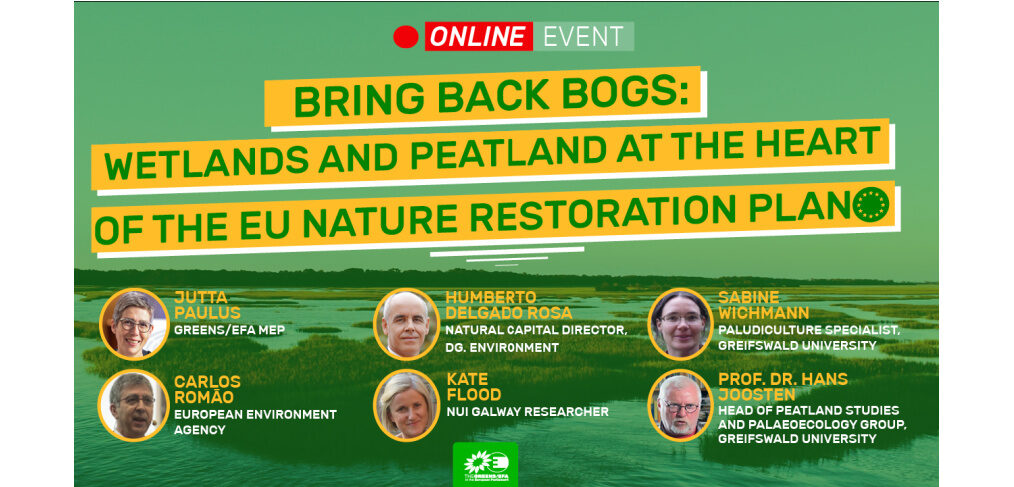
Online Event: “Bring Back Bogs: Wetlands and Peatlands at the Heart of the EU Nature Restoration Plan”
Please find here a preliminary recording.
Watch the conference on Youtube:
Thursday, December 3rd 10:00 AM – 12 PM
We are honoured to invite you to our top-class webinar with the following guests:
- Carlos Romão European Environment Agency, Biodiversity and Nature Policy Unit – Presentation:2020-12-03_SoN _peatlands
- Humberto Delgado Rosa, Director of Natural Capital, DG. environment
- Prof. Dr.Dr.Dr.h.c Hans Joosten, University of Greifswald, head of the group moor studies and paleoecology – Presentation: 201203 Bring back bogs – The Great Rewetting
- Sabine Wichmann, University of Greifswald, specialist in paludiculture – Presentation: Wichmann-Paludiculture_03-12-2020
- Kate Flood, researcher at NUI Galway, advocate for community and citizen engagement in wetlands – Presentation: EUGreensConfBogsDec2020Kate_Flood
- Jutta Paulus, MEP Greens / EFA
In addition, Environment Commissioner Virginijus Sinkevičius will send us a video message.
The translation will be offered in 3 languages (English / French / German), the webinar will be recorded and accessible online afterwards.
At after every presentation there will be time for a quick Q&A and at the end we will have a bigger discussion. Register yourself and discuss with us!
Registration is limited to 500 people on a first come, first serve basis. The webinar will also be streamed on Facebook (link to follow), but only in English.
Why Bogs? Because bogs are amazing!
They cover only 3% of the world’s land area, but store twice as much carbon as forests. Most endangered species depend on healthy wetlands for their survival, and their population decline is directly related to the decline of bogs and wetlands.
Bogs going down the drain(age).
The main reason for their poor condition is the drainage for agricultural use.
The State of Nature(SON) Report 2020 of the European Environmental agency (EEA) showed that 50% of dune habitats and bog, mire and fen habitats have a bad conservation status, showing strong deteriorating trends. To stop this, around 9 % of their total area needs to be restored (approximately 10 900 km2).
We need to ad(d)mire (to) nature:
Next year, the EU Commission will present the “EU Nature Restoration Plan” (Part of the EU Biodiversity strategy). This Plan will include a new legal framework for nature restoration, with binding targets to restore damaged ecosystems, including the most-carbon-rich ones (aka Bogs).
Therefore, we would like to bring Wetlands and Peatland into the centre of the attention.
Win-Win Wetlands:
Another aim of the conference is to promote sustainable uses of wetlands and peatland. Paludiculture combines the reduction of greenhouse gas emissions from drained peatlands through rewetting with continued land use and biomass production under wet conditions and shows ways of using wetlands and peatland sustainably!
Biomass from “wet” peatlands is traditionally used for thatched roofs and walls but novel insulation products provide renovation materials with an extremely favourable life cycle assessment, taking into account the low energy use in production and the possibility to compost any waste. Other peatland products can be used for combustion (pellets, briquettes),
Peatland plan:
At the end of the conference, we will present our green demands for a future restoration and protection of peatland and wetlands and will open this up for public consultation.
We want to hear your opinion!
You can find our draft here:
Green Demands -Draft for public consultations
Please send your feedback to jutta.paulus@europarl.europa.eu
